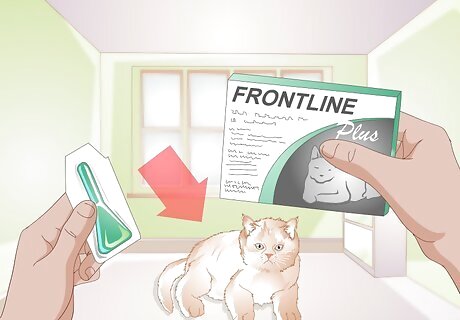
views
Applying Frontline Plus

Ensure Frontline is right for your cat. You can use Frontline Plus on your cat if they are eight weeks old or older and weigh more than 2.2 lbs (1kg). Talk to your veterinarian before administering Frontline Plus to cats who have other medical problems, or cats that are aged, breeding, pregnant, nursing, or taking other medications. Always read the instructions for use before applying. If your cat has skin lesions or irritation, talk to your vet before applying Frontline Plus.

Ready the Frontline Plus. If your cat is wearing a collar, remove it. Remove the applicator from the package. Holding the applicator upright, flick the neck to ensure the product is in the main body of the applicator, not the tip. Break off the end of the tube at the score line by snapping it away from your face and body.

Apply the medication. Hold the cat securely so they cannot move. You might need a friend or family member to hold the cat for you while you apply Frontline Plus. Part the cat's hair on the back of their neck so the skin is exposed. Place the tip of the applicator on the cat’s skin and gently squeeze the applicator until it is empty. Applying Frontline Plus to the area between the shoulder blades is important because that is an area out the cat's reach, where it will not be pawed at or licked off. Do not apply Frontline Plus to your cat’s fur. The medicine is absorbed through the skin, and will not work if it only soaks the pet’s fur.

Follow appropriate aftercare guidelines. After you’ve administered Frontline Plus to your cat, do not allow the animal to go swimming or bathe for at least 24 hours. Frontline Plus is also flammable, so keep your cat away from open heat or flame for 24 hours after administering. Frontline might cause irritation at the application site. Don’t worry if you see your cat itching or scratching immediately after using the medication; however, if itching or irritation persists, contact your veterinarian. Do not use Frontline Plus on your cat more than once per month. If you continue to have flea or tick infestations, re-apply the medication after one month.
Applying Frontline Spray

Use caution. Before applying Frontline Spray, put on latex or rubber gloves. Find a well-ventilated area to administer the spray. Wear a long-sleeved shirt to prevent the spray from getting on your skin. If you get the spray on your skin or clothing, take the clothing off and rinse your skin beneath running water for about 15 minutes. If you get it in your eyes, rinse your eyes under running water for about 15 minutes. Remove contact lenses, if present, after five minutes. Call your doctor for further treatment. Do not use the spray on cats younger than eight weeks old. After spraying your cat, keep them away from intense heat or open flame, since the medicated spray is flammable.

Select the dose rate. The dose rate is either short, medium, or high. Knowing the dose rate your cat needs will help you decide how many pumps of the Frontline Spray to apply. Use a low dose rate (six pumps of a 100 milliliter spray per kilogram of the cat’s body weight, or two pumps of a 250 milliliter spray per kilogram of the cat’s body weight) when your cat has short, fine fur, healthy skin, and few or no fleas. Use a medium dose (nine pumps of a 100 milliliter spray per kilogram of the cat’s body weight, or three pumps of a 250 milliliter spray per kilogram of the cat’s body weight) if your cat has short or medium-thick fur or a moderate flea population. Use a high dose (12 pumps of a 100 milliliter spray per kilogram of the cat’s body weight, or four pumps of a 250 milliliter spray per kilogram of the cat’s body weight) when the cat has lots of fleas, thick or long fur, hypersensitivity to fleas, or has ticks.

Determine the number of sprays your cat needs. The number of sprays you’ll use depends on the size of your cat and the size of your Frontline Spray bottle. You can determine the exact number of sprays your cat will need by consulting the chart located beneath the pull-away label on your bottle of Frontline Spray. Larger cats will need more Frontline Spray. Cats getting sprayed with the larger (250 milliliter) bottle will need fewer sprays than a cat of equal weight getting sprayed with the smaller (100 milliliter) bottle.

Spray the cat. Hold the cat still by grabbing them by the scruff of their neck. Ruffle the cat’s fur with the hand that is not holding the spray bottle to ensure the spray reaches the cat’s skin. With the nozzle about three inches (five centimeters) from the cat’s body, spray the requisite number of pumps onto the cat by depressing the handle on the squeezable bottle. Spray evenly across their body so as not to apply an excessive amount to just one spot. Rotate the nozzle clockwise to deliver Frontline in a cone of spray. Rotate the nozzle counterclockwise to deliver the spray in a more concentrated way. Start at the back of the neck and work your way down the length of the cat’s body. Ensure that the cat's head, body, legs, chest, and tail all receive the spray. Do not spray the medicine directly in the cat’s face, ears, or eyes. To apply Frontline Spray to a cat’s face, spray a bit on your glove or onto a cloth, then gently apply it to the face, taking care to avoid the eyes and ears. You might want a friend or family member to restrain the cat while you administer the spray. Hold the cat still for a few minutes after administering the spray until it dries.

Identify how long to wait before treating your cat again. If your cat has ticks, you should administer Frontline Spray once every four weeks. If your cat has hypersensitivity to fleas or is sporting a high flea population, you should also apply Frontline Spray once every four weeks. If your cat is getting a low or medium dose of spray, you can administer it in slightly longer intervals of six weeks before giving your cat another dose.
Preventing Tick and Flea Infestations

Limit your cat’s outdoor time. When cats wander about outdoors — especially when they encounter strange cats or dogs — the likelihood that they will contract fleas or ticks increases. But even extended time alone in their own backyard can increase your cat’s risk for fleas and ticks, since these bugs can be found anywhere, especially during spring, summer, and fall.

Feed your pet supplements. Keeping your pet healthy with a well-balanced diet and good nutrition gives them healthy skin that could help control flea infestations. Vitamins C and B are the most effective at keeping your cat’s skin healthy. Feed your cat a chewable vitamin B or C (available at your local pet store), or add a liquid vitamin supplement to their water. Avoid feeding your cat meaty cat foods, as these are usually made with low-quality meats that are unfit for human consumption. You could also add a spoonful of coconut oil to your cat’s food or water to keep their skin healthy.

Check your cat regularly for fleas and ticks. After your cat comes back inside, part their fur and look for small brown or black spots that could be bugs. Pay attention to prolonged scratching, chewing, or licking behavior that might indicate the presence of fleas or ticks. After walking about outside, you should also check your clothing for fleas and ticks to avoid bringing them in with you. Wash your cat regularly. After drying them, comb them thoroughly with a flea comb to remove potential bugs. Place any fleas you find in a jar, then seal the jar and place it in the freezer to kill them.




















Comments
0 comment